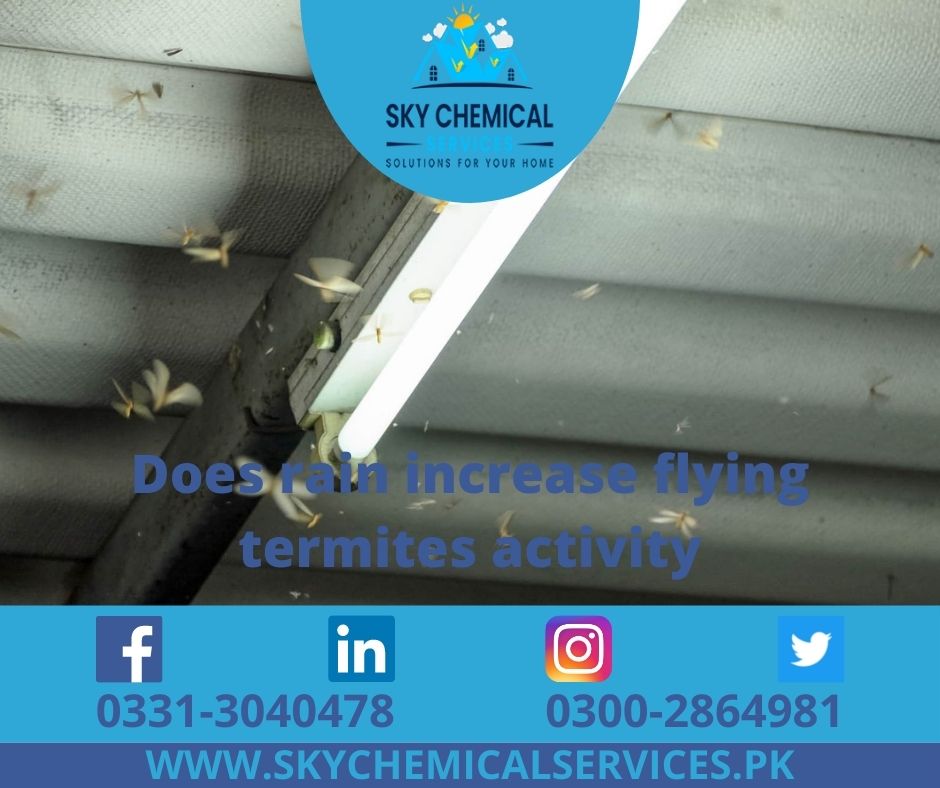
After a rain in the spring, it’s fairly uncommon to observe flying termites. Swarmer’s (also known as alataes) usually emerge from the earth, tree stumps, or foundation cracks in homes and buildings. Their mission is to leave the nest, find a partner, and start a new termite colony – one that may someday house thousands, if not millions, of children.
Termites After Rain
Rain helps to moisten the habitat, making termite survival more likely because there is enough of water available. Thousands of winged re productive may swarm from the colony after a heavy spring or fall rain, looking to mate and create new colonies. Warm temperatures, humidity, and the colony’s age are more important factors than rain in causing swarming.
These swarmer’s can’t fly very far and usually stay within a 100-meter radius of their original colony. As a result, if you encounter termite swarmer’s in or around your home, they are most likely swarming from a nearby location. Formosan termites are the exception to this rule, as they can fly quite well.
When the swarmer’s land and shed their wings as part of the mating process, the pair builds a small subterranean chamber and the female begins laying eggs, a new colony is born. In reality, only a small percentage of the swarmer’s that fly each year mate and start new colonies, and even fewer achieve maturity, which can take years. Swarmer’s, on the other hand, can live for a long time if they survive. A termite queen can live for 30 years or more.
Termite Types
While termites come in a variety of forms, the three most common are subterranean, dry wood, and damp wood termites. These species require water for their survival.
Subterranean termites build mud tubes that they use as tunnels to infiltrate dwellings and scavenge for food — wood — while they generally live in underground colonies.
Dry wood termites eat dry, sound wood like structural timber, utility poles, decks, fences, and stored lumber and fences. They get the moisture they need from the wood they’re infesting.
Damp wood termites infest rotting wood that retains moisture, either via contact with the ground or from exposure to a water leak. Damp wood termites aren’t likely to infest homes since they usually infest wood that has already been damaged and because they aren’t very common. Concerning damp wood species have a small range and are usually only a problem in homes with a lot of dampness for a long time. The only termite that acquires moisture from free water is the damp wood termite.
Chemicals used for Termite Proofing.
Termite Colonies
Termites, like bees, ants, and wasps, are eusocial insects that live in complexly structured colonies directed by one or a few queens. Labor is split in these colonies, and each termite class has its own job. The worker termites work together to raise the young. When they reach adulthood, this new generation of termites assists their elders. The colony is guarded by the soldiers. The swarmer’s (also known as alataes or re productive) are in charge of reproduction. The termite queen is in charge of laying eggs.
Swarmer’s can sometimes appear from within your home. Fortunately, the sole purpose of these termites is to reproduce and establish new termite colonies. They are unable to eat wood, rarely live, and may be swept up or removed with a vacuum cleaner. Their presence, on the other hand, is a strong indicator that you may have a termite infestation.
Don’t take any chances if you observe termite indications. Allow one of our highly trained termite control technicians to do a free inspection of your house by calling Sky Chemical Services. We’ll give you with a solution if we find proof of a termite infestation. It’s a good idea to contact a termite control professional even if you don’t currently have termite activity.
Flying Termites or Ants?
Flying Termite aren’t the only airborne insects that can be found after a rainstorm. Flying ants have a similar look, making it difficult to tell them apart. The following are the most noticeable visual differences between them:
Flying termite are characterized by straight antennae, equal wing length, and a straight waist.
Flying ants have a constricted waist, bent antennae, and variable wing length.
Conclusion
Termites are known for hampering the wood décor of any home or office. They are airborne insects which tend to make colonies through different ranks (soldier, queen, etc.). They are also visible after a rainstorm as water is one of their vital sources of energy. Flying Termite, not only damage properties within the premises but also outside; for instance, tree-houses, fence, etc.
If you want to know more about our services, visit (https://www.skychemicalservices.com)
